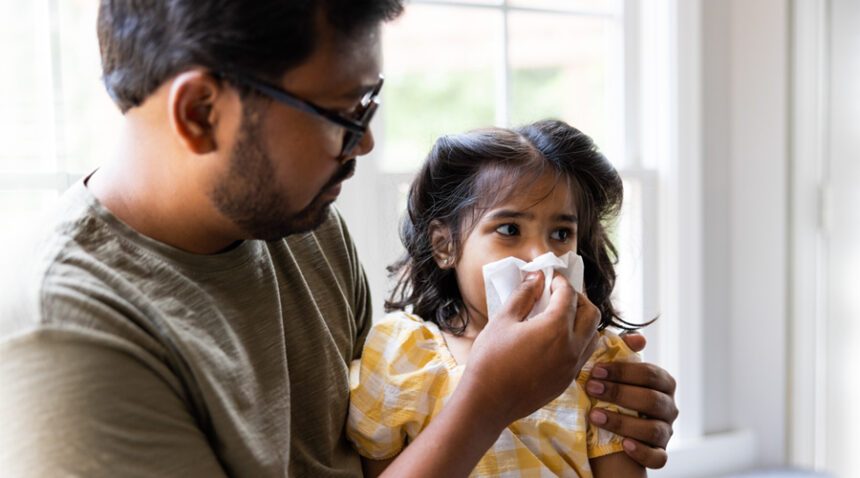Children bring home many wonderful things from day care and school—knowledge, improved skills, new friends. In the fall and winter, though, it may seem as if they also bring home a new virus every week. While most adults experience two to four colds per year, young children can have as many as 10.
It’s difficult to see your child struggling with the symptoms of a cold, which include congestion, sneezing, coughing, sore throat, achiness and exhaustion. Because there is no cure for a cold, the virus must run its course, which usually takes a week or two. It can be especially challenging, however, to nurse a child through a cold only to see them immediately become sick with another one.
“Parents should have a lot of grace and compassion for themselves during cold season,” says UNC Health pediatrician Priyanka Rao, MD. “Many kids have back-to-back illnesses. Children have a lot of exposure to viruses through their activities, and since their bodies haven’t seen those viruses, it’s expected that they’ll get sicker more often.”
Dr. Rao shares advice on how to keep children comfortable when they’re sick with a cold.
Staying Home to Rest and Hydrate
A child with a fever should stay home. Once a child has been fever-free for 24 hours without the help of ibuprofen or acetaminophen to bring down the fever, then it may be possible to return to school and other activities.
“It depends on the kid,” Dr. Rao says. “If older kids can cover their coughs and sneezes, they may be able to return to school and activities sooner. With younger kids, they may need an extra day or two at home. When they cough or sneeze, you don’t want to see respiratory particles in the air that could cause spread of the virus.”
While your child is home, the main task should be resting.
“The body recovers during rest,” Dr. Rao says. “Allow a child to sleep in or take longer naps than usual.”
A day off from school doesn’t mean the entire day is spent in bed, though.
“If the child feels up to playing, they can,” Dr. Rao says. “Most kids have good barometers, and when they need to rest, they will.”
In addition to encouraging rest, parents should ensure that children are eating when they have an appetite and drinking plenty of water.
“Hydration is really important,” Dr. Rao says. “Make sure your child is peeing every six to eight hours as a general measure of whether they’re drinking enough fluids.”
Symptom Relief for a Child’s Cold
You can help your child stay comfortable during a cold by helping to alleviate symptoms.
For fever and pain, Dr. Rao recommends acetaminophen such as Tylenol or ibuprofen such as Motrin; talk to your child’s pediatrician or check the medication’s label for the correct dosage.
“We don’t recommend over-the-counter cough and cold medicines for kids age 6 and under,” Dr. Rao says. “Some of those medications may work for kids older than 6, but for younger kids, stick with Tylenol or Motrin.”
For a stuffy nose, use saline drops or spray. A humidifier in your child’s bedroom will help to thin out mucus while sleeping. You can also put on a hot shower and let the child play in a steamy bathroom, which helps to break up snot and mucus.
If your child is old enough, help them to blow their nose. For small kids, you may have to use a bulb syringe or a nasal aspirator to remove mucus.
For cough, try giving a child older than 12 months a teaspoon of honey. Kids older than 6 can use cough or throat drops.
When to Seek Medical Care for a Child’s Cold
For the most part, the symptoms of a cold will resolve in a week or two. A visit to the doctor usually isn’t necessary, but Dr. Rao says parents shouldn’t hesitate to contact their child’s pediatrician if they’re concerned.
“You know your child best, so if you’re worried, give us a call,” she says. “We can provide advice over the phone or determine if you should come in.”
Some symptoms warrant a call to your child’s doctor for further instructions:
- Any trouble breathing, including hard or rapid breathing, an inability to catch their breath or unusual noises during coughing
- A fever that lasts longer than three days
- Not drinking much; not using the bathroom or producing a wet diaper every six to eight hours
Children with a cold are at risk for secondary infections, including ear infections, lung infections and, in the case of older children, sinusitis. These conditions may require antibiotics prescribed by a doctor.
Hand Hygiene During Cold and Flu Season
Need something to do at home with a sick child? Use the time to model good hand hygiene. Thorough hand-washing is an important skill for children to learn, as it can slow the spread of viruses, especially in the household.
“When a parent and kid are sick at the same time, that’s a hard combination, so do whatever you can to protect the rest of the family,” Dr. Rao says.
In addition to frequent hand-washing, parents should disinfect high-touch surfaces, including doorknobs, toys and cellphones.
If you’re concerned about your child’s health, talk to your pediatrician. Need a doctor? Find one near you.

